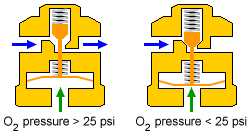|
Low-pressure
Gas Supply
The low pressure
gas supply carries gas from the regulator to the flowmeters, quick-flush
and ventilator at a pressure of 50 psi. It may take the form of:
- Hard-plumbing,
usually copper pipe and compression connectors.
- Flexible
hose.
Identification
Correct
identification of the gas being supplied to the patient remains
vital. This may be achieved by:
- Color-coding
of pipework and hoses.
- Gas-specific
connectors used on the hose running from remote cylinders to the
anesthetic machine.
Quick-connectors
Several different quick-connect systems
are available that enable rapid disconnection and re-connection
of the anesthetic machine from a central piped gas supply.
Hazards
- Leaks
in the low pressure gas supply are quite common and should be
repaired as soon as possible.
- Fires
and explosions may be caused by the oxidizing ability of oxygen
and nitrous oxide: no grease must used in the threads of the valves
or connectors.
- Cross-connection
of gas hoses is potentially lethal, but should be prevented by
use of the correct, gas-specific connectors.
This
problem is most likely to occur in veterinary practices that attempt
to economize by using inexpensive compressed air fittings for
both oxygen and nitrous oxide. This practice
is very dangerous.
- Hypoxic
gas mixtures
Most modern machines incorporate some form of device to prevent
it from supplying a hypoxic gas mixture if the oxygen supply fails.
This shuts off the other gases (such as nitrous oxide) when the
pressure in the oxygen line falls.

Some machines
also incorporate an audible low oxygen pressure alarm.
Quick-flush 
|

